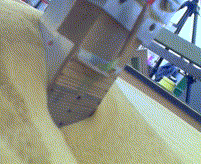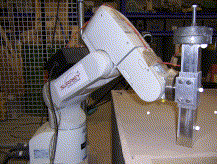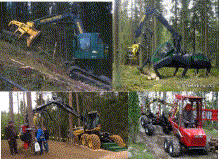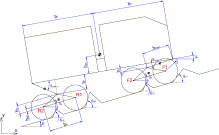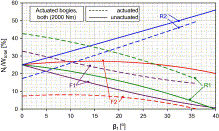Gregory P. Scott, Chakravarthini M. Saaj
The development of a soil trafficability model for legged vehicles on granular soils
Journal of Terramechanics, Available online 7 March 2012, ISSN 0022-4898, 10.1016/j.jterra.2011.12.002.
http://www.sciencedirect.com/science/article/pii/S0022489811001133
Abstract: This paper extends previous research in planetary microrover locomotion system analysis at the University of Surrey through the development of a legged microrover mobility model. This model compares various two- and three-dimensional soil cutting models to determine the most applicable model to legged locomotion in deformable soils, and is flexible to use any of these models depending on the leg shape, sinkage and other conditions. This baseline draught force model is used for determining the soil forces available for legged vehicle locomotion, as well as the soil thrust available to the vehicle footprint. Empirical investigations were performed with a robotic arm in planetary soil simulants to validate a legged mobility model through determination of the draft force of a robotic leg pushing through soil at constant and varying sinkage levels. The resulting locomotion performance model will be used to predict the ability of the legged vehicle to traverse a specific soil. An introduction to the planetary soil simulants used in this study (SSC-1 quartz-based sand and SSC-2 garnet-based sand) and the process used to determine their mechanical properties is also briefly presented to provide a baseline for this research.
Keywords: Hexapod locomotion; Soil simulant; Trafficability; Microrovers; Draught force; Rover mobility
J. Pijuan, M. Comellas, M. Nogués, J. Roca, X. Potau
Active bogies and chassis levelling for a vehicle operating in rough terrain
Journal of Terramechanics, Available online 2 April 2012, ISSN 0022-4898, 10.1016/j.jterra.2012.03.001.
http://www.sciencedirect.com/science/article/pii/S0022489812000201
Abstract: Four axle vehicles with bogies can adapt the position of the wheels to follow irregularities in the terrain, having an obstacle surpassing ability far greater than conventional 2-axle vehicles. Still, the ability to overcome discrete obstacles on a steep slope is very different depending on the wheel that is facing the obstacle. A possible solution to diminish this variation can be found if the vehicle is able to actively redistribute the load on each wheel. One strategy is to design the suspension mechanism so it can regulate its height, being able to level the chassis. Also, an active torque on the pin join between the bogie and the chassis can be applied with the same goal, adopting a system of active bogies. Both solutions have been parametrically studied in a bi-dimensional multibody model of a 4-axle vehicle with double bogies. The results show an improvement independent of obstacle position and terrain angle when using active bogies. With height regulation, this improvement is limited to the rear bogie wheels, but the obstacle surmounting capacity of the vehicle as a whole can be considerably increased if the optimal regulation point is found. Possible applications for such enhanced vehicles with bogies are performing different tasks in forest areas with obstacles on steep slopes or unstructured terrain exploration.
Keywords: Off-road; Rough terrain; Bogie; Traction; Obstacle surmounting; Parametrical model; Active; Chassis levelling; Levelling
Jixin Wang, Naixiang Wang, Zhenyu Wang, Yingshuang Zhang, Lin Liu
Determination of the minimum sample size for the transmission load of a wheel loader based on multi-criteria decision-making technology
Journal of Terramechanics, Available online 19 April 2012, ISSN 0022-4898, 10.1016/j.jterra.2012.02.001.
http://www.sciencedirect.com/science/article/pii/S0022489812000055
Abstract: The present paper aims to provide a new approach in estimating the minimum sample size of the transmission load of a wheel loader under multiple operating conditions based on multi-criteria decision-making (MCMD) technology. Extreme load values (ELVs) and load cycles under multi-operating conditions are carefully considered, and the mean and the standard deviation of ELVs and the fatigue life are the three criteria selected for estimating the sample size. Using MCMD, the weight values of the three criteria are determined, where the eigenvector and entropy information methods, together with linear combination weighting, are adopted. The optimal minimum sample size (MSS) is estimated based on the feasible values determined by the three criteria and their corresponding weight values. As an example, the load time history of the semi-axle of a wheel loader is analyzed in detail. As the ELVs and load cycles are studied, the optimal MSS can properly represent the load characteristics. The objectivity and validity of the optimal MSS are assured using the combination of the eigenvector and entropy information methods.
Keywords: Sample size; Multi-criteria decision-making; Extreme load value; Load cycle; Load spectrum; Wheel loader

